HY-1C/1D (HaiYang-1C/1D)
EO
Ocean colour instruments
Ocean
Ocean colour/biology
Quick facts
Overview
| Mission type | EO |
| Agency | CAST, NSOAS |
| Mission status | Operational (nominal) |
| Launch date | 07 Sep 2018 |
| Measurement domain | Ocean, Land, Snow & Ice |
| Measurement category | Ocean colour/biology, Multi-purpose imagery (land), Albedo and reflectance, Surface temperature (ocean), Sea ice cover, edge and thickness |
| Measurement detailed | Land surface imagery, Earth surface albedo, Sea surface temperature, Ocean suspended sediment concentration, Sea-ice cover |
| Instruments | COCTS, CZI |
| Instrument type | Ocean colour instruments, Imaging multi-spectral radiometers (vis/IR) |
| CEOS EO Handbook | See HY-1C/1D (HaiYang-1C/1D) summary |
Related Resources
HY-1C/1D (HaiYang-1C/1D) - Ocean Observation Satellites of China
Spacecraft Launch Mission Status Sensor Complement References
The Chinese HY-1C satellite, launched on 7 September 2018, is a follow-on mission of the HY-1A and HY-1B missions of NSOAS (National Satellite Ocean Application Service), Ministry of Natural Resources (MNR) of China. The overall objective is to monitor global ocean color and SST (Sea Surface Temperature) with a spatial resolution of 1 km, a temporal resolution of 1 day and with a swath of more than 2900 km, as well as the coastal zones’ environment with a spatial resolution of 50 m and a swath of more than 950 km.
Spacecraft
The structure of the spacecraft is based on the CAST968 bus, a box-shaped minisatellite with overall dimensions of 1.4 m x 1.1 m x 0.953 m. The spacecraft was designed and developed by the DFH (Dongfanghong Satellite Corporation Ltd.) from CAST. The total deployed length of HY-1 is about 7.5 m.
The CAST968 bus is the first modern small satellite bus developed by DFH and it has been successfully applied on several missions. The bus uses an integrated electronic system and its good performance and flexibility can meet broad payload requirements.
The CAST968 platform was built on eight subsystems: structure and mechanism, thermal control, attitude and orbit control, power supply, TT&C, antenna, housekeeping and electrical subsystems. The main structure of the bus was of aluminum honeycomb sandwich panels.
The spacecraft is 3-axis stabilized (Earth pointing) using bias momentum control. The AOCS (Attitude and Orbit Control Subsystem) uses three magnetorquers and hydrazine propulsion for attitude control and orbit change maneuvers; the attitude accuracy is 0.4º in roll and pitch and 0.5º in yaw. Attitude sensing is provided by digital sun sensors and infrared Earth sensors.
The data sent from the HY-1 satellites is received and processed in several ground stations located at Beijing and Hangzhou – receive raw data in real time acquiring, processing, archiving and managing, distributing and analyzing, SanYa, Hainan and Mudanjiang – receive raw data in real time and transfer to Beijing.
The launch mass of HaiYang-1C is 442 kg with a dry mass of 429 kg (each satellite). The design life is 5 years.
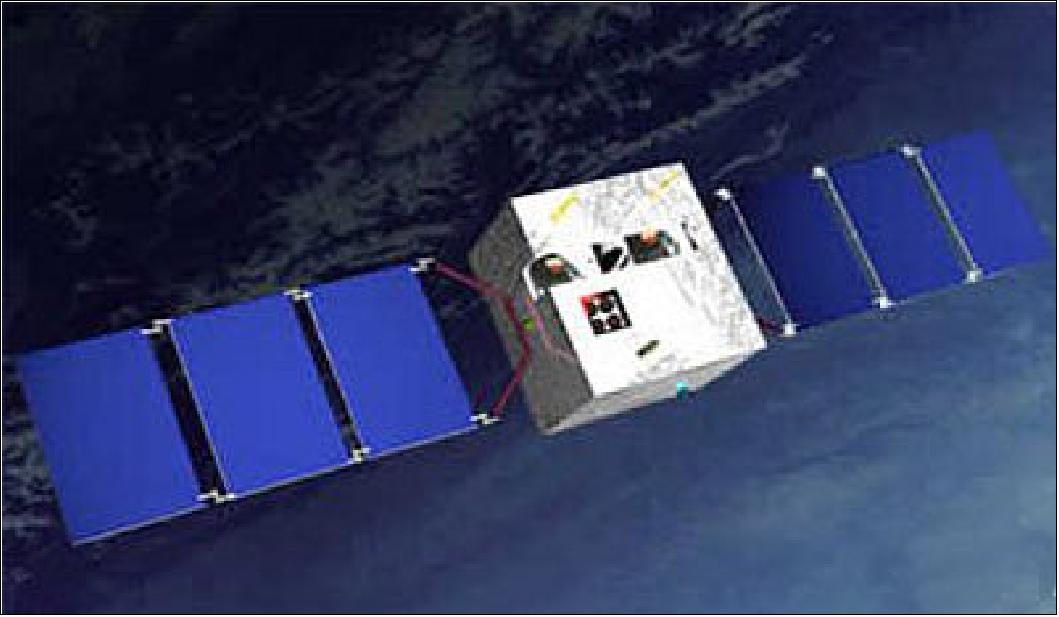
Launch - HY-1C
The HY-1C ocean monitoring minisatellite, HY-1C was launched on 7 September 2018 (03:15 UTC) from the TSLC (Taiyuan Satellite Launch Center) in China, using a Long March-2C (CZ-2C) vehicle. 1)
Orbit
Sun-synchronous orbit, altitude of 780 km, inclination = 98.6º, LTDN (Local Time on Descending Node) = 10:30 ±30 min.
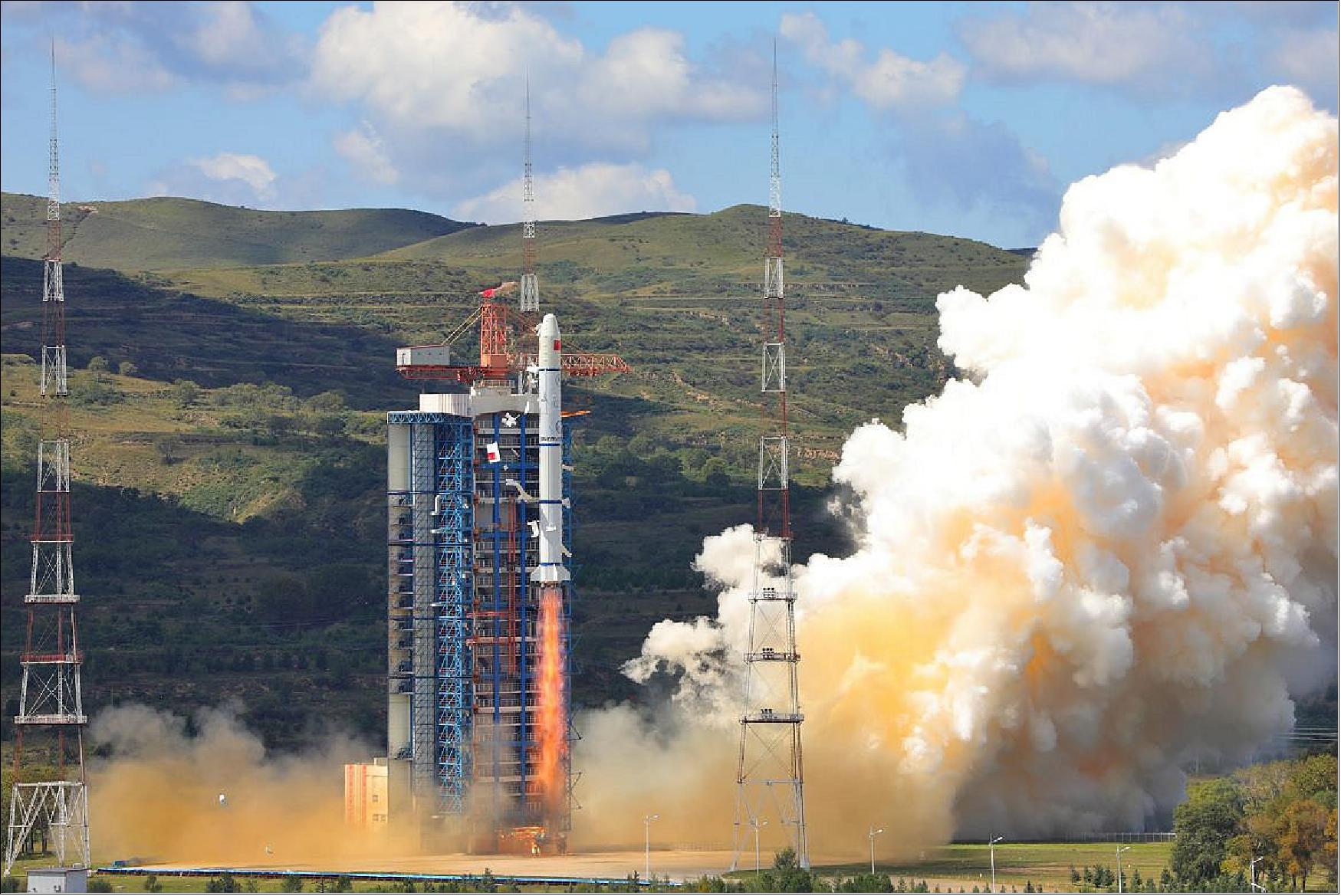
Launch - HY-1D
The HY-1D ocean monitoring minisatellite was launched on 10 June 2020 (18:31 UTC) from the TSLC (Taiyuan Satellite Launch Center) in China, using a Long March-2C (CZ-2C) vehicle. 2)
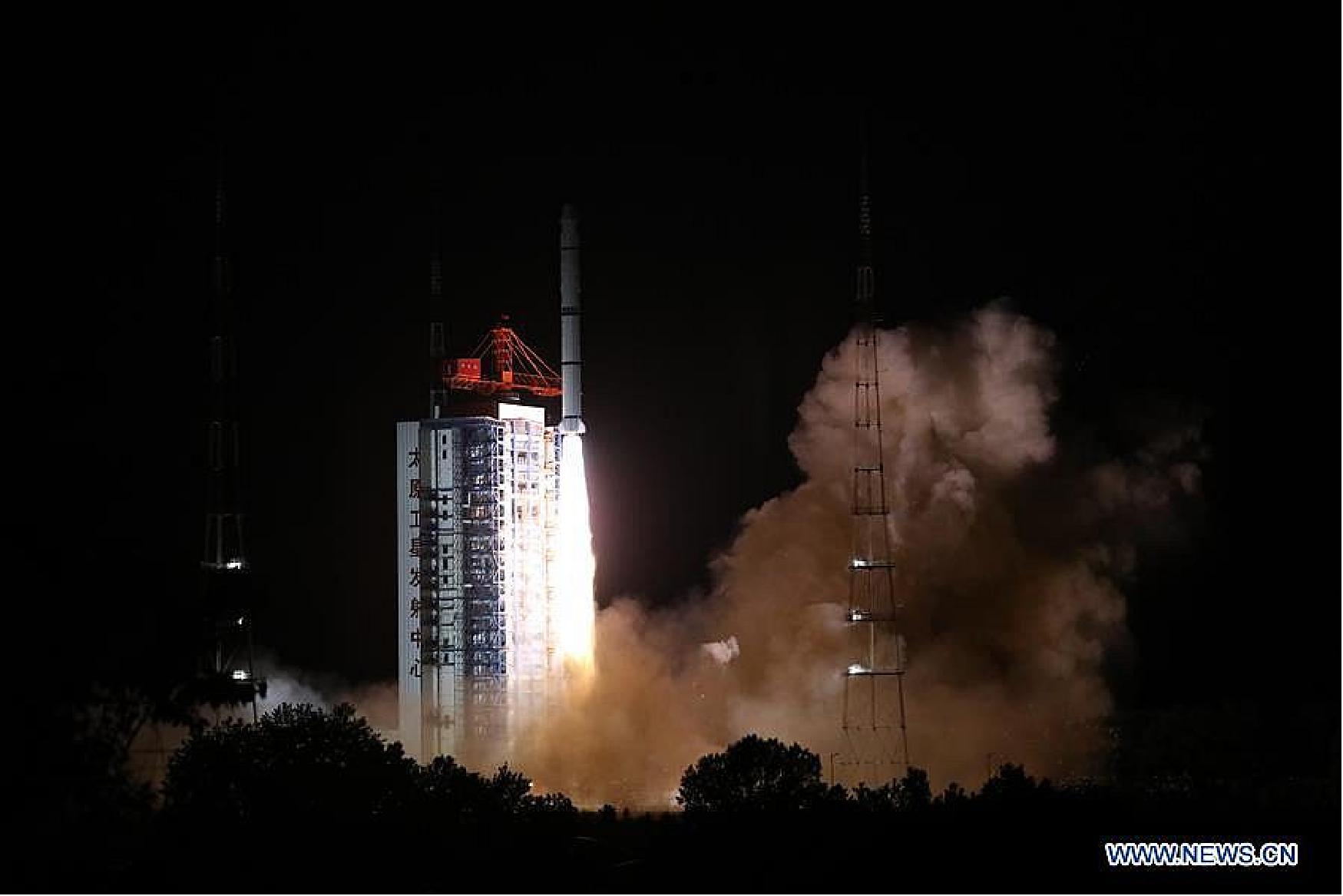
Orbit
Sun-synchronous orbit, altitude of 780 km, inclination = 98.6º, LTAN (Local Time on Ascending Node) = 13:30 ±30 min.
The spacecraft is based on the CAST2000 bus.
The sensor complement of the HY-1D satellite and other descriptions are the same as those of the HY-1C satellite. The data products of the HY-1D mission will be distributed to the public after the completion of in-orbit tests.
The spectral bandwidth of the 7th band of COCTS (China Ocean Color and Temperature Scanner) onboard HY-1D is 734 to 754 nm (730 to 770 nm for COCTS onboard HY-1C), (Ref. 3).
Mission Status
• May 2020: The HY-1C spacecraft and its instruments are operating nominally. 3)
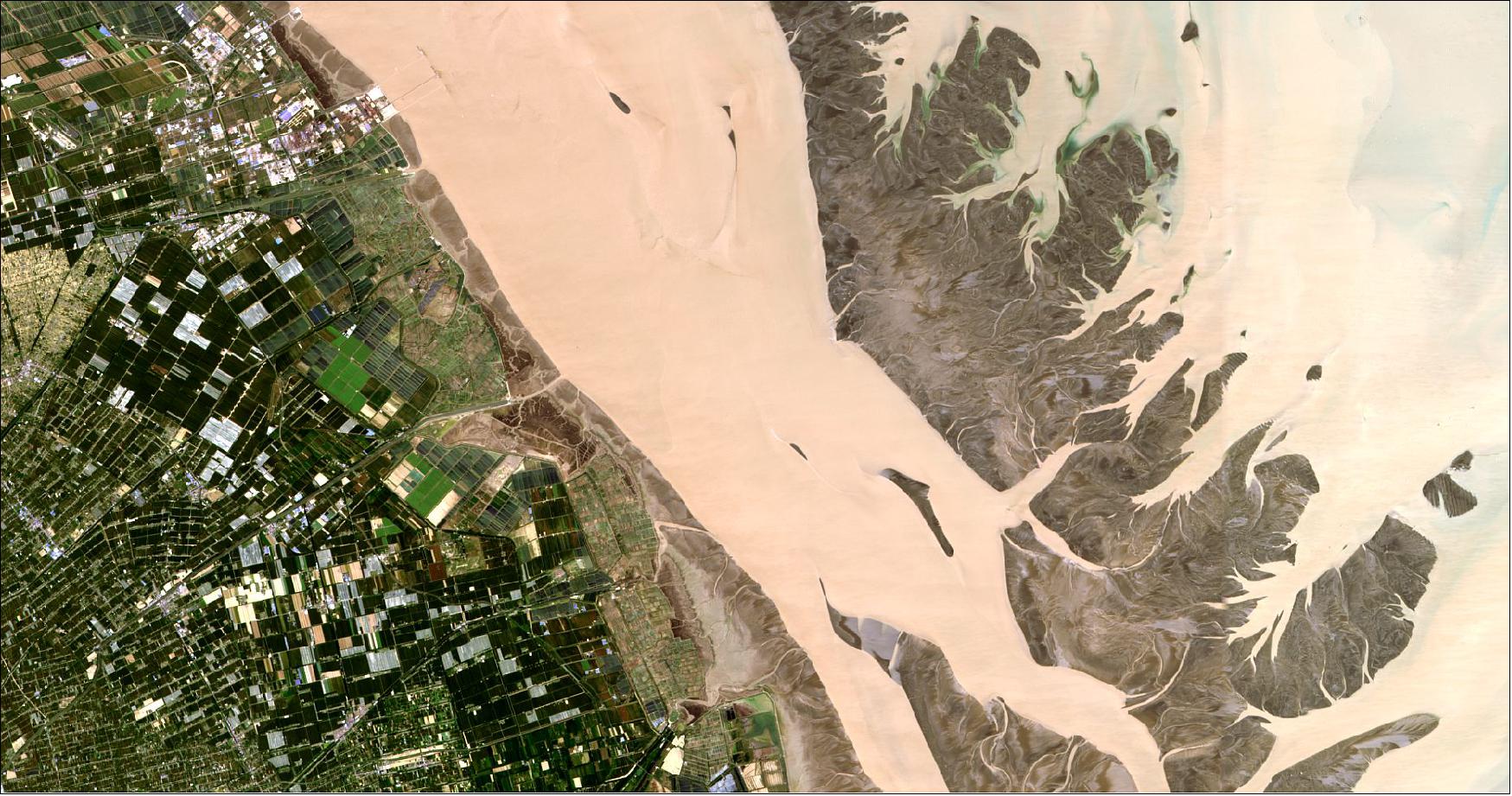
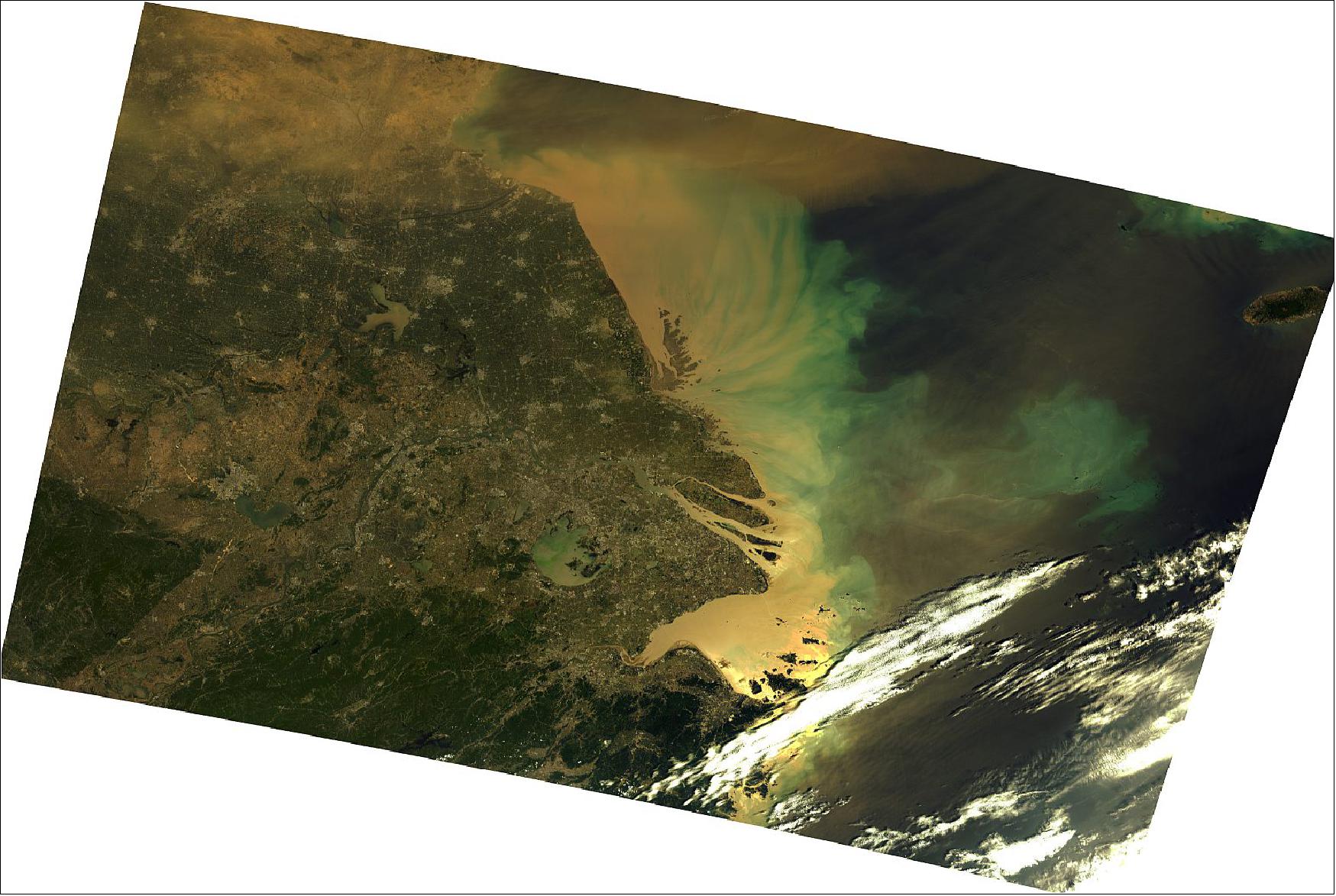
• 2019: The HY-1C satellite can provide many data products to the public,including ocean color products,SST and NSST (Nighttime Sea Surface Temperature). These products are classified to level 0-level4. L1 data are the radiances of all visible and near-infrared bands after calibration,L2 data are the standard ocean color and SST products (Figure 6),L3data are the grid products with a grid resolution of 4 km and 9 km. L4 data are the grid merged products with multiple data sources. 4)
- In general, the L1 to L4 products of HY-1C satellite can be distributed to the public for free.
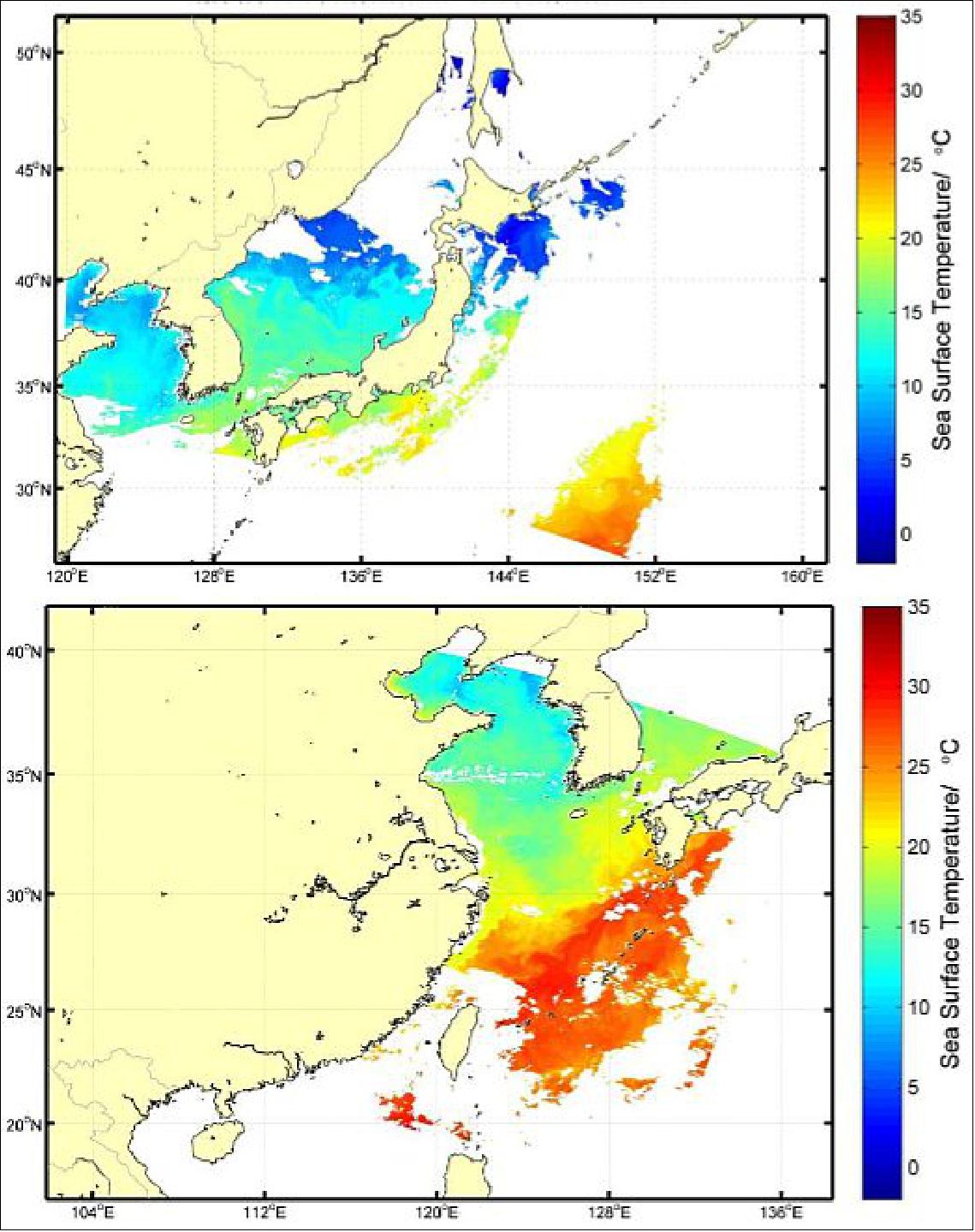
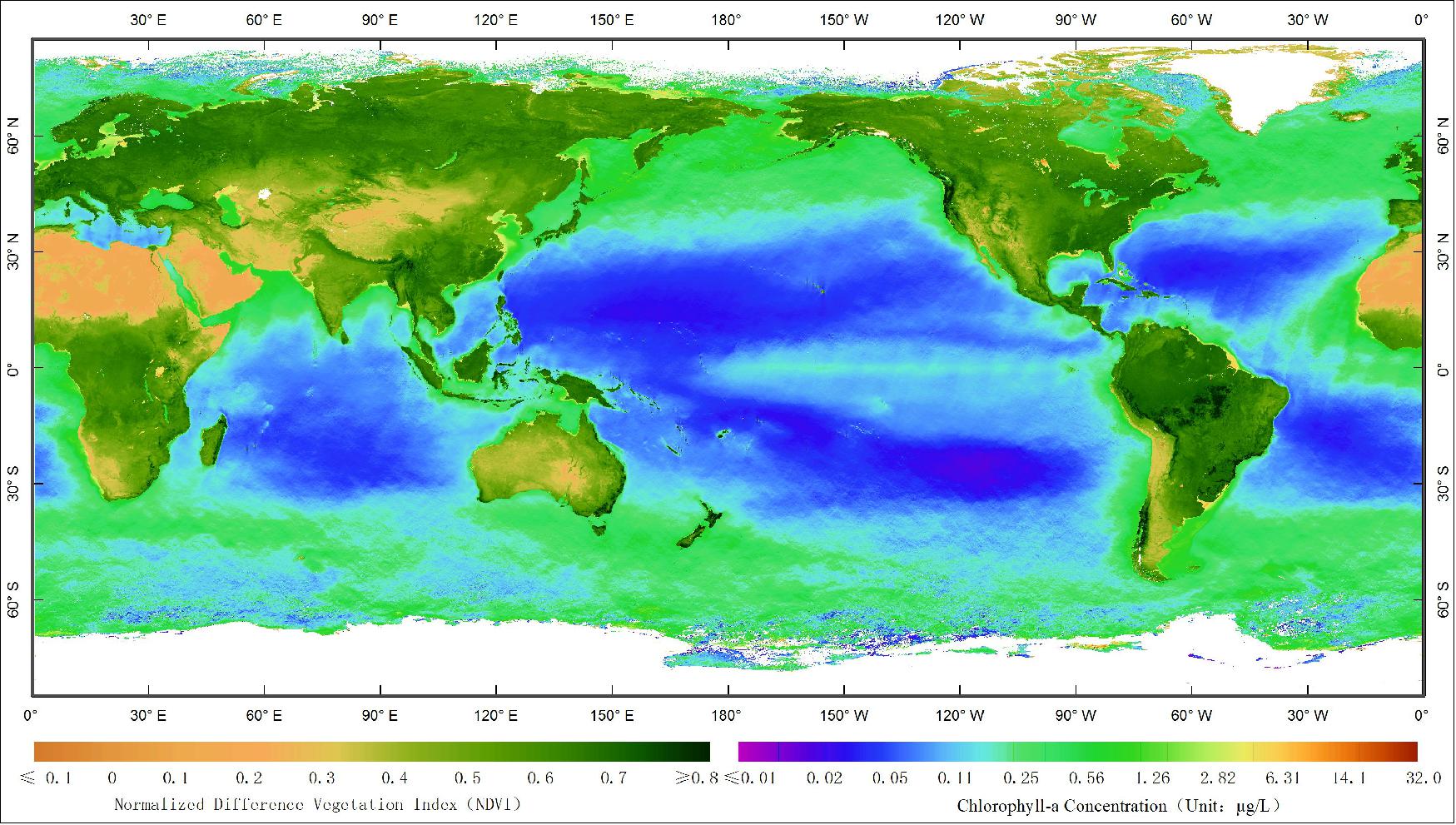
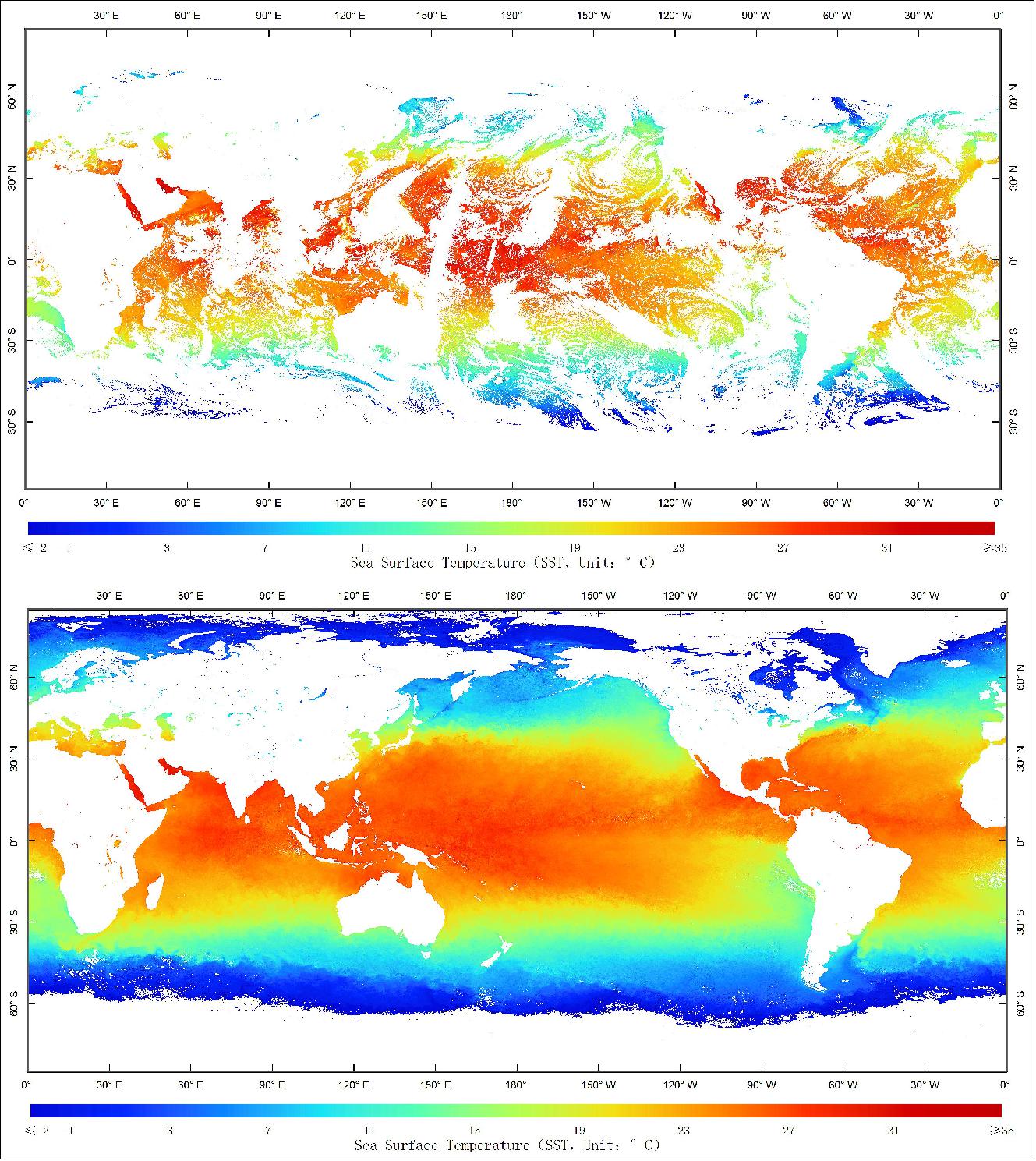
Sensor Complement
The Haiyang-1C (HY-1C) is equipped with the following instruments (Ref. 3):
COCTS (China Ocean Color and Temperature Scanner)
COCTS, the main payload on-board the China Haiyang-1C (HY-1C) satellite,is an optical radiometer to detect ocean color and surface temperature by 8-channel visible and near-infrared bands and 2-channel thermal infrared bands (10.3~11.3 µm and 1.5~12.5 µm). COCTS of HY-1C detects global ocean and land twice a day, provides daily ocean color,land vegetation products as well as daytime SST (Sea Surface Temperature) and NSST (Ref. 4). 5)
COCTS instrument parameters: mass=50 kg, power=70 W, data rate = 670 kbit/s. 6)
Band No | Bandwidth (µm) | Measuring condition [1] | SNR | Max radiance [2] | Observation objective |
1 | 0.402-0.422 | 9.10 | 349 | 13.94 | Yellow substance, water pollution |
2 | 0.433-0.453 | 8.41 | 472 | 14.49 | Absorption of chlorophyll |
3 | 0.480-0.500 | 6.56 | 467 | 14.59 | Chlorophyll, sea water optics, sea ice |
4 | 0.510-0.530 | 5.46 | 448 | 13.86 | Shallow sea topography, sediment or low concentration |
5 | 0.555-0.575 | 4.57 | 417 | 13.89 | Chlorophyll, sediment of low concentration |
6 | 0.660-0.680 | 2.46 | 309 | 11.95 | Sediment of medium and high concentration, |
7 | 0.730-0.770 | 1.61 | 319 | 9.72/5.0[3] | Atmospheric correction, sediment or high concentration |
8 | 0.845-0.885 | 1.09 | 327 | 6.93/3.5[3] | Atmospheric correction |
9 | 10.30-11.30 | NEΔT = 0.2 K (at 300 K) | 200-320K[4] | SST (Sea Surface Temperature), sea ice | |
10 | 11.50-12.50 | NEΔT = 0.2 K (at 300 K) | 200-320K[4] | SST (Sea Surface Temperature), sea ice | |
[1] Typical input spectral radiance (mW cm-2 µm-1 sr-1) | |||||
[2] Unit: mW cm-2 µm-1 sr-1 | |||||
[3] Dynamic range can be set to two switches and is adjustable (the default is low switch) | |||||
[4] Brightness temperature measurement range | |||||
CZI (Coastal Zone Imager)
CZI is a pushbroom instrument with the objective to monitor vegetation and the coastal zone. Observations are performed in 4 bands in the VIS/NIR region. The pushbroom instrument features 21800 pixels/line on a swath of 950 km, the spatial resolution is 50 m.
The CZI (Coastal Zone Imager) is mainly used to obtain real-time image data of the sea-land interaction area for coastal zone monitoring, to understand the distribution of suspended sediment in key estuary harbors, and to conduct real-time marine environmental disaster monitoring and warning including sea ice, red tide, green tide and pollutants.
Bandwidth (µm) | Measuring condition[1] | SNR | Max radiance[2] | Observation objective | ||
L: turbid water | M: 35% | H: 80% | ||||
0.42-0.50 | 4.57 | 410 | 14.0 | 21.0 | 48.3 | Chlorophyll, water pollution, sea ice, shallow sea topography |
0.52-0.60 | 2.46 | 300 | 14.0 | 21.0 | 47.0 | Chlorophyll, sediment of low concentration, wetland |
0.61-0.69 | 1.09 | 248 | 12.0 | 18.0 | 39.0 | Sediment of medium concentration, vegetation, soil |
0.76-0.89 | 1.09 | 240 | 4 | 12 | 25 | Vegetation, sediment of high concentration, atmospheric correction |
[1] Typical input spectral radiance (mW cm-2 µm-1 sr-1) | ||||||
[2] Dynamic range can be set to three switches and is adjustable (The default is low switch switch.). Radiance unit: mW cm-2 µm-1 sr-1. | ||||||
UVI (Ultraviolet Imager)
The objective is to improve the atmospheric correction accuracy of high turbid water in the near shore.
Band (µm)[1] | Measuring condition[2] | SNR | Max radiance[2][3] | Observation objective |
0.345-0.365 | 7.5 | 1000 | 35.6/18.5 | Atmospheric correction of turbid water, dissolved organic matter |
0.375-0.395 | 6.1 | 1000 | 38.1/16.5 | Atmospheric correction of turbid water, dissolved organic matter |
[1] The spectral range corresponds to the spectral range of the 50% transmission of the normalized system | ||||
[2] Typical input spectral radiance (mW cm-2 µm-1 sr-1) | ||||
[3] Dynamic range can be set to two switches and is adjustable (The default is low switch.). The data is simultaneously transmitted. | ||||
SCS (Satellite Calibration Spectrometer)
The objective is to provide on-board synchronous calibration for the 8-band COCTS and the 2-band UVI instruments, to monitor the in-orbit radiation stability for COCTS and UVI. The visible, near-infrared spectrum of the payload has the ability to transmit 5nm bandwidth continuous spectral data in the 400~900 nm range and the in-orbit solar calibration ability. The bands of the payload include 2 UV and 8 visible, near-infrared bands of COCTS.
Band No | Center wavelength (µm) | Bandwidth (µm) | Typical radiance ((mW/cm2 µm sr) | SNR |
1 | 0.355 | 0.02 | 7.5 | 1000 |
2 | 0.385 | 0.02 | 6.1 | 1000 |
3 | 0.412 | 0.02 | 9.10 | 800 |
4 | 0.443 | 0.02 | 8.41 | 950 |
5 | 0.490 | 0.02 | 6.56 | 1000 |
6 | 0.520 | 0.02 | 5.46 | 1000 |
7 | 0.565 | 0.02 | 4.57 | 950 |
8 | 0.670 | 0.02 | 2.46 | 800 |
9 | 0.750 | 0.04 | 1.61 | 750 |
10 | 0.865 | 0.04 | 1.09 | 950 |
AIS (Automatic Identification System)
The objective is to obtain the ocean ship location and the attribution information and to provide data services for marine right maintenance, marine disaster prevention and mitigation, and marine fishery production activities.
- 1) Function: in-orbit collect, store, and forward AIS messages globally
- 2) Signal frequency: simultaneously detect four frequency points
- a) band 1: 161.975 MHz
- b) band 2: 162.025 MHz
- c) band 3: 156.775 MHz
- d) band 4: 156.825 MHz
- 3) Receiving sensitivity: -112 dBm
- 4) Swath width: ≥950 km.
Distribution Policy
The copyright of China's Ocean Satellite data is owned by MNR of China. More information can be found from NSOAS (http://www.nsoas.org.cn/eng/). The data access can be found from Ocean Satellite Data Distribution System (https://osdds.nsoas.org.cn/#/). All data products are distributed to the public for free by NSOAS under their data usage agreements (http://www.nsoas.org.cn/eng/column/153.html).
References
1) Rui C. Barbosa, ”Haiyang-1C launched by China’s Long March 2C,” NASA Spaceflight.com, 7 September 2018, URL: https://www.nasaspaceflight.com/2018/09/haiyang-1-launched-by-chinas-long-march-2c/
2) ”China successfully launches new ocean observation satellite,” XinhuaNet, 11 June 2020, URL: http://www.xinhuanet.com/english/2020-06/11/c_139130557.htm
3) ”Information provided by Dr. Xiaomin Ye of National Satellite Ocean Application Service (NSOAS), Ministry of Natural Resources, Beijing, China; Key Laboratory of Space Ocean Remote Sensing and Application, SOA, Beijing, China.
4) Xiaomin Ye, Qimao Wang, Jianqiang Liu, Lijian Shi, Bin Zou, Jing Ding, Qingjun Song, ”Sea Surface Temperature of China Ocean Color and Temperature Scanner (COCTS) onboard HY-1C Satellite,” 2019, Frascati, Italy, URL: https://adf5c324e923ecfe4e0a-
6a79b2e2bae065313f2de67bbbf078a3.ssl.cf1.rackcdn.com/GHRSST%20XX%20-
%202019%20Frascati%20-%20Italy/58-Xiaomin-Ye-G-XX-Poster-58-NSOAS.pdf
5) Mingkun Liu, Christopher J. Merchant, Lei Guan and Jonathan P. D. Mittaz, ”Inter-Calibration of HY-1B/COCTS Thermal Infrared Channels with MetOp-A/IASI,” Remote Sensing, Volume 10, No 8, Published: 25 July 2018, https://doi.org/10.3390/rs10081173, URL: https://www.mdpi.com/2072-4292/10/8/1173/htm
6) ”Instrument COCTS,” OSCAR (Observing Systems Capability Analysis and Review) WMO, URL: https://www.wmo-sat.info/oscar/instruments/view/88
The information compiled and edited in this article was provided by Herbert J. Kramer from his documentation of: ”Observation of the Earth and Its Environment: Survey of Missions and Sensors” (Springer Verlag) as well as many other sources after the publication of the 4th edition in 2002. - Comments and corrections to this article are always welcome for further updates (eoportal@symbios.space).
Spacecraft Launch Mission Status Sensor Complement References Back to top